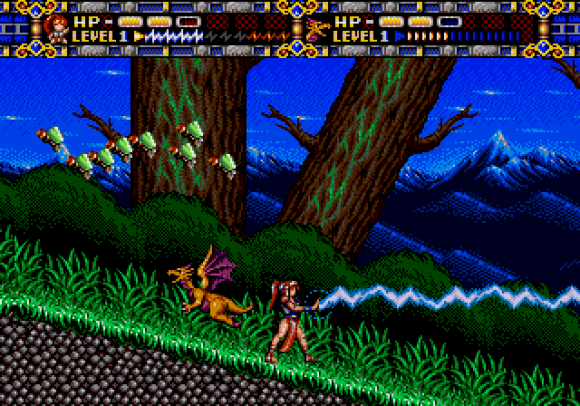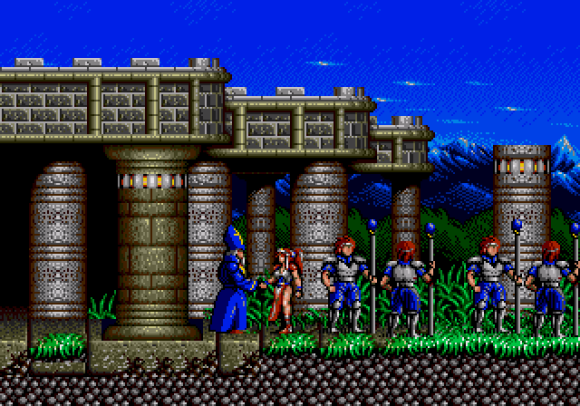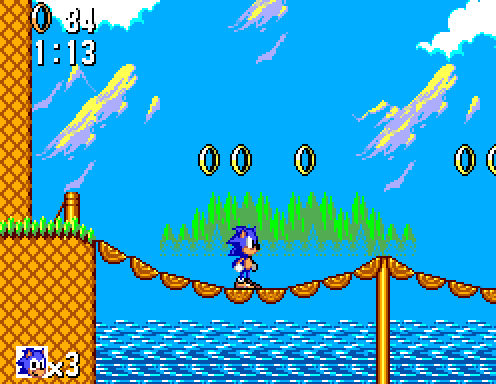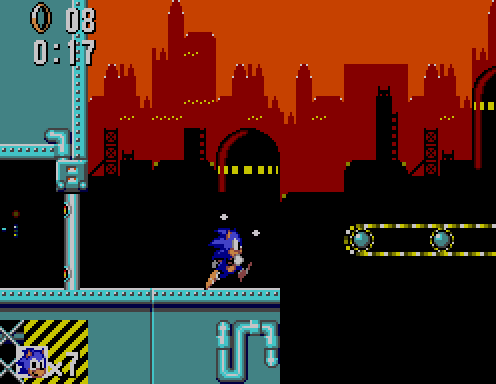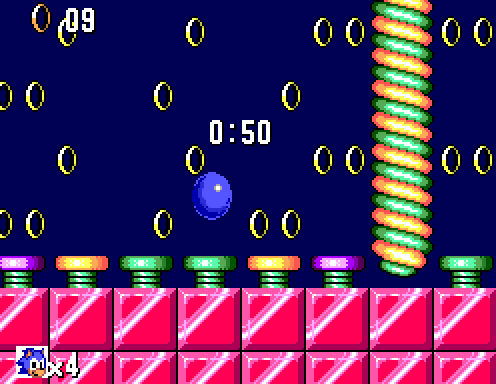Volumes 1 and 3 of The Complete A-Z of Sega Games, a series of review compilations from games magazine SegaPro, were the gaming bibles of my youth. As I mentioned in my Master System Sonic retrospective, I spent endless hours reading them, and while I did use them to guide the odd purchase, the primary pleasure I derived from them was of indirectly experiencing a vast range of games I would never be able to play. But today the wide range of games in the two volumes are closer to my grasp than ever before. They’re available as inexpensive digital downloads, eBay bargains, and even as free ROM downloads if other methods fail. And so I’ve decided to create my own A-Z of Sega games: I’ll take one game for each letter of the alphabet, play it, and then see how both the game and the SegaPro review hold up to modern day scrutiny. I’ve decided to start with Alisia Dragoon, a shooter/platfomer for the Mega Drive.
SegaPro reviewer James Scullion had high praise for Alisia Dragoon, describing it as “graphically great, musically masterful, particularly playable and delightfully difficult” and “a great combination of quality gameplay and excellent aesthetics”. He gave it a final score of 85%. I played through the game from beginning to end. Do I agree with his assessment? Um, well… no.
In Alisia Dragoon you guide the titular Alisia through a range of hazardous levels, striking down foes with your lightning as you go. You can also fight off enemies with a relatively innovative extra feature – a range of magical familiars that attack enemies. There’s a mild RPG element too: both Alisia’s lightning magic and her familiars can level up, gaining extra power and health bars. Alisia herself is a pretty decent stab at a female protagonist, visibly feminine but not scantily clad or exploitative. All this sounds pretty good for a Mega Drive game, and it would make a reasonably promising foundation for a game even today, but unfortunately Alisia Dragoon squanders its potential.
We’ll start with the superficial – Alisia Dragoon just isn’t that aesthetically pleasing. The review in my guide is dripping with praise for the aesthetics: “The backdrops are excellent; all the enemies are particularly well-coloured and animated; Alisia moves in a no-messin’ kind of way which the programmers have taken great care to invoke.” But while the graphics aren’t terrible, particularly the character sprites, they don’t seem especially well-crafted and feature a dreary washed-out colour palette. None of it stands out today; all of it is forgettable. Except, that is, for the well-crafted opening sequence, where detailed hieroglyphics scroll by to a suitably atmospheric piece of music. And speaking of music, my guide speaks well of that too.
There are 21 kickin’ in-game tunes, including Elizabethan waltzes, techno moshes, medieval fripperies and New Age meditationals, all of which add marvellously to the scenario.
It hardly feels like we’ve been playing the same game. The music starts out reasonably well, the opening sequence is nicely composed and some of the early music is quite catchy but the soundtrack becomes completely forgettable fairly quickly. You certainly wouldn’t buy the soundtrack album. But while James Scullion is impressed with the music, he’s positively thrilled by the sound effects.
Sound effects number a staggering 100+ (the largest number I’ve come across yet!) and range in diversity from alien cats meowing to bongo drums in space. All are loud ‘n’ proud, and deserve full volume, despite what your neighbours might say!
This is the review at its most cute and anachronistic – remember the days when reviews discussed things like the number of sound effects? Alas, these effects are nowhere near as interesting and diverse as they sound.

This is an artist's impression of what the end of the third level looks like. No-one has ever seen it because it's impossible to get through the endless gauntlet of vicious, virtually invincible cannons at the start.
As a whole, Alisia Dragoon doesn’t really work. The core gameplay isn’t particularly fun. It sounds good on paper – frazzling enemies with giant bolts of lightning – but in reality you just hold down the lightning button and the enemies are automatically targeted with beams of lightning, which can spray out across the screen to deal with multiple foes. There’s a certain lack of autonomy that makes it unsatisfying – because you can’t target the lightning properly, the experience doesn’t feel personal or satisfying. You aren’t experiencing smiting enemies with lightning, you just feel like you’re pressing a button to make the computer hurt the enemies. This means you’re more inclined to blame the game when things go wrong – it’s difficult to target particular threats – and that’s not good for a game as difficult as Alisia Dragoon. Also, later in the game it requires ridiculous amount of lightning to destroy enemies, even at high levels, which makes combat tedious.
Alisia Dragoon‘s most promising feature, its selection of summonable familiars, doesn’t really work either. Properly implemented they could have been a real asset to the game, something to make it stand out from similar fare. Unfortunately familiars aren’t very useful and die quickly; they become unavailable until you find a revival item and reset to level one when they perish. This even stood out to the reviewer in 1992: “All the familiars protect your rear but seem rather ineffectual in heavy flak. Still, their intentions are honourable.” And that, of course, is the most important thing.
The game’s campaign is a bit weird and inconsistent. The first level is split into three sub-levels, giving the impression of a fairly meaty game, but the subsequent levels are much more brief. The setting abruptly veers from fantasy to sci-fi and back again, and while there is an interesting-looking level set in a stricken alien spaceship, it ends in a rather baffling boss battle where your fantasy heroine faces off against an evil priest manipulating guns with his telepathic powers in a rapidly descending, nigh-on epilepsy-inducing, lift. The structure is strange and unreadable – what appears to be a mid-level mini-boss turns out to be the final boss of the level, a viciously hard boss encounter signals the end of another level, only for the player to be cruelly thrust into an upward ascent up a rock face, pelted with damaging boulders all the way. To top it all off (spoiler alert!) the game ends with Alisia turning home, victorious in her battle to save the world from the game’s evil super-villain, to find that her only reward is a handshake from the village priest. Baffling.
What really breaks the game, however, is the difficulty and structure. In Alisia Dragoon you get one life. One. One life and a tiny health bar to last you eight horribly, utterly, difficult levels, levels containing bosses with almost unlimited endurance, levels filled with enemies constantly spewing out attacks which the not-very-dexterous Alisia struggles to avoid. It’s artifice, the kind of difficulty that comes from the desire to transform a short game into an impregnable behemoth worthy of £40. This wasn’t as apparent in 1992. The review notes that bosses require a ‘phenomenal amounts of hits’ – but as a positive. Another positive: “Life energy runs out all too soon”. Yay for death! But times have changed – Alisia Dragoon no longer has to justify the £40 price tag that it was designed and distorted around, leaving a game that seems frustrating and badly designed. I cheated to see the end of Alisia Dragoon, and I’m frankly not ashamed to say it. I’d have struggled to scrounge up the ability to reach the end of Alisia Dragoon, but finding the will would have been impossible.
So no, I don’t agree with James Scullion’s assessment of Alisia Dragoon back in 1992. I can understand why his enthusiasm for the graphics and sound exceeds mine – standards have changed and it’s also hard not to unfairly compare early Mega Drive titles against later ones like Sonic the Hedgehog 3. His views on difficulty seem anachronistic now – I can’t see many reviewers praising unreasonably small health bars these days. Another anachronisms are more charming. In one place he notes that the levels are “professionally programmed”. Simpler times.
Ultimately, Alisia Dragoon is a product of its time, a mediocre early Mega Drive game, artificially padded out with a crushing difficulty level. The levels, however professionally programmed they are, lack charisma. Alisia Dragoon is a game that is difficult to play but easy to forget.
